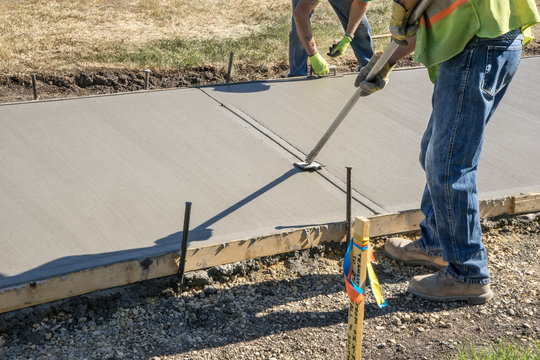When planning any construction project involving concrete—whether it’s a driveway, shed foundation, or industrial floor—one of the most critical questions is: How thick should the concrete slab be? The answer depends on several factors, including the intended use, soil conditions, load-bearing requirements, and environmental factors.
In this comprehensive guide, we’ll break down everything you need to know about concrete slab thickness, ensuring durability, strength, and compliance with industry standards.
What Factors Determine the Thickness of a Concrete Slab?
Answer:
The thickness of a concrete slab depends on multiple factors, including:
- Purpose of the Slab: Different applications require varying thicknesses. For example, a sidewalk (4 inches) is much thinner than a highway slab (11–12 inches).
- Expected Load: Heavy vehicles (trucks, RVs) demand thicker slabs (6–8 inches) compared to light-duty use (cars, foot traffic).
- Soil Quality: Weak or expansive soils may require deeper foundations or reinforced slabs to prevent cracking.
- Climate Conditions: Freeze-thaw cycles in colder regions necessitate thicker slabs to prevent heaving.
- Reinforcement Needs: Steel rebar or wire mesh can reduce required thickness by enhancing tensile strength.
- Local Building Codes: Municipal regulations often specify minimum thickness requirements for different structures.
Each of these factors must be evaluated to determine the optimal slab thickness for durability and cost-efficiency.
What Is the Recommended Thickness for Residential Concrete Slabs?
Answer:
For residential applications, the standard concrete slab thickness varies based on use:
- Sidewalks & Walkways: Typically 4 inches thick. If crossing driveways or supporting light vehicles, increase to 5–6 inches.
- Driveways:
- Passenger Vehicles (Cars, SUVs): 4 inches is sufficient.
- Heavier Vehicles (RVs, Trucks): 5–6 inches is recommended.
- Garage Floors: Usually 5–6 inches, with reinforcement for heavy tools or storage.
- :Patios & Outdoor Slabs 4 inches is standard unless heavy furniture or hot tubs are involved (then 6 inches).
- House Foundations (Slab-on-Grade): Typically 4–6 inches, but may require deeper footings in unstable soils.
Thicker slabs (6+ inches) are advisable in areas with poor soil drainage or high load demands.
How Thick Should a Concrete Slab Be for Commercial and Industrial Use?
Answer:
Commercial and industrial slabs must withstand heavier loads and higher traffic volumes, requiring greater thickness:
- Parking Lots:
- Standard Cars: 6 inches minimum.
- Trucks & Heavy Vehicles: 8–12 inches near loading docks.
- Warehouse Floors: 6–8 inches, with reinforcement for forklifts and machinery.
- Highways & Roadways: 11–12 inches for interstate highways due to constant heavy traffic.
- Industrial Driveways & Aprons: 8–10 inches to endure frequent truck movement.
Reinforcement (rebar or post-tensioning) is often mandatory in these applications to prevent cracks under stress.
Does Soil Type Affect Concrete Slab Thickness?
Answer:
Yes, soil type significantly impacts slab thickness and foundation design:
- Stable Soil (Clay, Gravel, Sand): Standard thickness (4–6 inches) usually suffices.
- Expansive Clay or Loamy Soil: Requires thicker slabs (6+ inches) and proper sub-base (compacted gravel) to prevent shifting.
- Soft or Poorly Drained Soil: May need deep footings, geotextile fabric, or soil stabilization before pouring concrete.
- Frost-Prone Regions: Slabs should extend below the frost line (12+ inches in cold climates) to avoid heaving.
A soil test before construction helps determine necessary adjustments.
How Important Is Sub-Base Preparation for Concrete Slabs?
Answer:
A well-prepared sub-base is crucial for slab longevity:
- Gravel Base (50–100mm thick): Provides drainage and prevents water pooling under the slab.
- Compaction: Ensures stability—poor compaction leads to settling and cracks.
- Damp-Proof Membrane (DPM): Plastic sheeting prevents moisture from rising into the slab.
- Slope & Grading: Directs water away to avoid erosion or frost damage.
Skipping proper sub-base preparation can lead to premature cracking and structural failure.
Should You Use Reinforcement in a Concrete Slab?
Answer:
Reinforcement enhances strength and prevents cracking:
- Rebar (Steel Bars): Ideal for heavy-load areas (driveways, industrial floors).
- Wire Mesh: Suitable for lighter applications (patios, sidewalks).
- Fiber Reinforcement: Added to the concrete mix for crack resistance.
For high-stress zones (garages, warehouses), rebar on 12–18-inch grids is recommended.
How Long Does a Concrete Slab Take to Cure?
Answer:
- Initial Set: 24–48 hours (walkable).
- Light Use: 7 days (light vehicles).
- Full Cure: 28 days (maximum strength achieved).
- Curing Methods: Keep moist (spraying, covering with plastic) to prevent rapid drying and cracks.
Avoid heavy loads during curing to prevent damage.
What Are Common Mistakes When Pouring a Concrete Slab?
Answer:
- Incorrect Thickness: Too thin = cracks; too thick = unnecessary cost.
- Poor Sub-Base: Leads to settling and uneven surfaces.
- Skipping Reinforcement: Increases risk of cracks under load.
- Ignoring Expansion Joints: Necessary to prevent stress cracks.
- Pouring in Extreme Weather: Hot/cold temperatures affect curing.
Following best practices ensures a durable, long-lasting slab.
Final Thoughts
Choosing the right concrete slab thickness depends on load requirements, soil conditions, climate, and reinforcement. Whether for a residential driveway (4–6 inches), industrial floor (6–12 inches), or sidewalk (4 inches), proper planning ensures structural integrity.
For large-scale projects, consulting an engineer ensures compliance with local codes. For DIY projects, following industry standards (like Australian AS 2870 for residential slabs) guarantees success.
By understanding these factors, you can build a strong, crack-resistant concrete slab that lasts decades.

